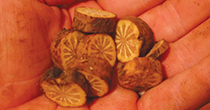Kava: The Relaxation Inducer ©2014
 by Joe Smulevitz by Joe Smulevitz
When most people in North America feel stressed, anxious, and restless and can’t sleep, they turn to sleeping pills, anti-depressants, or alcohol. In the South Pacific islands, the herb kava has been used for centuries to reduce stress, elevate mood, and improve sleep without the side effects of prescription drugs or alcohol. Kava (often referred to as kava kava in Polynesia or awa in Hawaii) is the name of both the plant (Piper methysticum), and a traditional pungent beverage prepared from the rootstock of the plant. In former times, kava was prepared by cutting the root into small pieces, and then chewed by several people, who spit the macerated pulp into a bowl, where it was mixed with coconut milk. The resulting mixture was strained before passing it around. This unsanitary method of preparing kava was replaced by the root being pounded or grated. A large number of high quality clinical trials have supported the traditional use of kava in the South Pacific islands as an effective treatment in the management of anxiety, restlessness, and stress. In addition to its significance as a medicinal agent, kava’s relaxing property has an important, long-established role in ceremonial events and social occasions in the South Pacific islands.
BOTANY
Kava is a hardy, slow-growing perennial shrub indigenous to many South Pacific islands from Hawaii to New Guinea. A botanical relative to black pepper, kava has large, heart-shaped, dark green leaves with pale yellow, tiny flowers, and a peppery aroma. The plant requires adequate shade and moist conditions and reproduces by means of its underground stems, also known as rootstalks, which grow laterally through the soil. Kava can climb to twenty feet high, although commonly harvested at seven or eight feet. Kava takes five to seven years to mature, with a minimum of four years maturity required to produce high quality kava.
CONSTITUENTS
The most important constituents of kava root responsible for the plant’s calming effects are substances called kavalactones. These compounds are naturally present in the plant’s dense, fleshy roots (some weigh up to 22 pounds). Kavalactones work by having a relaxing effect on the body’s limbic system, the part of the brain that regulates emotion.
DOSAGE
Look for products containing a certified per cent of kavalactones. For the treatment of mild to moderate anxiety, clinical trials indicate an effective daily dose ranges from 70 to 280 mg of kavalactones taken in three divided doses is often recommended. To promote better sleep, 135 to 210 mgs of kavalactones in one dose can be taken 30 to 60 minutes before bed. Do not use kava preparations containing non-root parts such as leaves and stems as well as stem peelings. They contain little of the active ingredient.
SAFETY
Unlike prescription drugs for anxiety, kava does not interfere with mental alertness and concentration, and it’s not addictive. However, do not use kava for more than three months without consulting a healthcare professional familiar with its usage. Do not take kava with other substances that affect the central nervous system such as alcohol, barbiturates, and other mood-altering drugs. People with Parkinson’s disease, liver problems, or taking medications that affect the liver should avoid kava, as well as pregnant or nursing women. Excessive use (not recommended) may result in temporary discolouration of the skin, hair, and nails, a side effect that goes away when kava is discontinued.
HISTORY
Cultivation of kava goes back 3,000 years to the island communities of the South Pacific including Polynesia, Melanesia, and Micronesia, spreading to other Pacific islands through exploration and trade. Kava was introduced to Europe following its description by naturalists aboard Captain James Cook’s expedition to the South Pacific in 1768. It was embraced as a plant of substance by Europeans shortly after its discovery in the Pacific islands. The first kava products appeared in Europe in the mid 1800s and were used in Germany for the treatment of gonorrhea and urinary tract infections. By the end of the 1800s, kava extracts were common in German herbal shops. Pharmaceutical preparations, offered as a tincture to lower blood pressure and as a mild sedative appeared in European dispensaries in 1920. Up until the 1950s, kava was listed for the treatment of gonorrhea and nervous disorders in the US Pharmacopeia, the official compilation of approved medicines.
During the 1950s, the first extensive studies on the activities of kavalactones occurred by German scientists. The findings determined that in laboratory animals, kavalactones exhibit sedative, anticonvulsant, analgesic, and muscle relaxant effects. This was followed by a number of clinical trials in the early 1990s, showing that kava may prove as beneficial as prescription drugs in the management of anxiety and tension. Benefitting by the favourable clinical studies, kava became one of the top selling botanical supplements in Europe and North America in 1996. In 2001, kava sales crashed when a European report raised concerns about liver related kava toxicity. The herb has enjoyed safe use in the South Pacific for centuries, and the premise that kava can cause liver toxicity is contrary to any previous scientific literature. Nevertheless, kava was withdrawn from the market in the European Union, the United Kingdom, and Canada. The US Food and Drug Administration advised consumers of the potential link to liver toxicity. In June of 2014, the kava ban was lifted in Germany. The Federal Administrative Court of Germany determined the ban was unlawful and inappropriate. Hopefully, the ruling will help pave the way for kava to become a top seller again in the herbal market.
Joe Smulevitz is a Chartered Herbalist, a Master Herbalist, a nutritional researcher, and author of numerous ealth articles. He can be reached at herbalistjoe@sympatico.ca.
|
